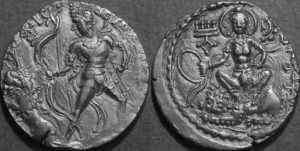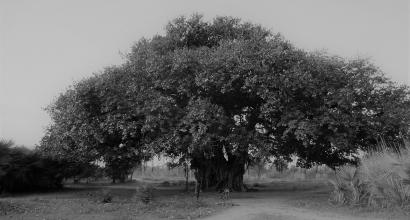Several historical evidences including some coins attest that Ramagupta assumed power after the demise of Samudragupta. We also have a play titled Devichandragupta authored by Vishakhadatta. However, the complete play is unavailable today. The extant version is available in the form of fragments of about five or six acts. The towering scholar, Dr. V Raghavan has compiled all of this in the appendix of his work, Bhojashrungaraprakasha.
According to this play, the Gupta throne naturally passed on to Samudragupta’s eldest son, Ramagupta who married a lady named Dhruvadevi. On occasion, when the royal couple had set out for a holiday at the mountains, a Shaka king cornered Ramagupta and took him prisoner. Seeing no other method of escape, Ramagupta was required to submit his wife Dhruvadevi to the Shaka king as ransom. When she heard this condition, Dhruvadevi felt intensely humiliated. At this juncture, Prince Chandragupta Vikramaditya arrived at the location, and understood the situation in depth. He then disguised himself as Dhruvadevi, climbed into the palanquin, killed the Shaka king in battle and returned victorious.
Ramagupta developed jealously at his brother’s success and attempted to inflict all sorts of atrocities against Chandragupta Vikramaditya. He even tried to get him murdered. During a shrouded battle one night, Chandragupta Vikramaditya, without realizing who was attacking him, killed Ramagupta. Later, he married Dhruvadevi and ascended the royal throne.
This is the summary of Devichandragupta.
The renowned Hindi scholar, poet, and playwright Sri Jayashankar Prasad has authored a drama titled Dhruvaswamini in Hindi based on this.
Numerous historians and scholars do not fully accept this story of Chandragupta Vikramaditya and Ramagupta as having historical merit. Indeed, the General Editor of the History and Culture of the Indian People volumes does not attach any importance to this story. But then it’s equally true that a serious poet like Vishakhadatta will not write a thoroughly cooked-up story. It appears that the authors of these volumes aren’t fully conversant with drama (Nataka) as a literary tradition. According to this tradition, the subject (Vastu) of a drama must essentially be based on Itihasa (loosely translated as history) and/or Purana. Individual episodes or scenes (Prakarana) may be derived from the poet’s imagination but the play itself must not be imaginary. Which means, it should be accurate in regard to the main historical details. For example, Kalidasa’s play Abhijnana Shakuntalam is different from the original story of Dushyanta occurring in the Mahabharata. The episodes of giving the finger-ring and Rishi Durvasa’s curse are Kalidasa’s creations. But the existence of Dushyanta and Shakuntala, Dushyanta’s suspicion of Shakuntala, and Bharata as their son—all these are facts that we learn from the Mahabharata, which we regard as Itihasa.
When we examine Devichandragupta in this light, it becomes clear that the behavior and characters of the Shaka King, Ramagupta, Chandragpta Vikramaditya and others must be retained intact. Therefore, it stands to reason that there is historical truth in the main subject of the play. Additionally, Banabhatta too recounts this episode in his Harshacharita.
On account of all these reasons, it is plausible to conclude that there was indeed a Gupta king named Ramagupta, that he was taken hostage by a Shaka King, that he lost his courage and reached a nadir where he had agreed to submit his own wife, that his younger brother Chandragupta rescued him, that he regarded this rescue as an insult and tried to murder his own brother, and was ultimately killed.
Those who view Chandragupta Vikramaditya’s marriage to Ramagupta’s wife with contempt need to notice an important factor. The meaning of the Sanskrit word Devara is “brother-in-law.” The Nirukta expands this word as “Dwitiyo varah devarah.” Among the Kshatriyas, there is a custom which allows a widow to marry her own brother-in-law. Even today, this custom exists in Punjab among the Jats. This is known as “Chaddar Daalna.” Back then, typically, the husbands would be part of the military and there was constant threat to their lives. Under such circumstances (when the husband died), there was an opportunity for the unfortunate wife to chart a new life thanks to this custom. Beginning with the Mrityusukta of the Tenth Mandala of the Rig Veda, and in the Arthashastra, Brihatsamhita, Parasharasmriti and other lore, there are ample references related to widow remarriage in our tradition.
People like Rahula Sankrityayana who raise a big din that women weren’t treated as equals in our tradition simultaneously view Chandragupta and Dhruvadevi’s marriage with contempt. As we have seen, that marriage was fully in keeping with the aforementioned Kshatriya custom. In which case, what does the stance of Rahula Sankrityayana show? It’s crystal clear that what such people want is not the truth but the worship of their own personal prejudices.
Kumaragupta was the son of Chandragupta Vikramaditya and Dhruvadevi. Chandragupta Vikramaditya’s other wife was Kuberanaga hailing from the clan of the Nagas. In those days, if a king had to acquire political stability, such marriages were inevitable. Even to this day, we observe such marriages in the world of business and politics. Be it big business houses, powerful political families, sportspersons, or cinema stars, they regard such marriages as essential for reasons greater than mere love and affection. Indeed, such marriages are part of routine news headlines. Despite this, one cannot entirely dismiss the fact that genuine love and affection does exist in such marriages.
In summary, we can say this much: as the Sanskrit proverb says, nadInAm sAgarO gatih (the river flows towards the sea), the wealthy and the powerful develop alliances only with kindred souls. The success and hardships of such marriages will be managed by the couple. Why should we pour scorn upon these alliances? If two kingdoms stop warring with each other and their subjects lead a peaceful life as a result of such marriages, why should we object to it?
Chandragupta Maurya married Selucus Nikator’s daughter, Helen. As a consequence, the Greeks living in Bahlika (Bactria) and the Indians living in this side of the border experienced a peaceful regime. Chandragupta Vikramaditya gave his daughter, Prabhavatigupta in marriage to Pravarasena of the Vakatakas. The Vakatakas ruled over the region that roughly corresponds to Telangana today—the entire geography lying below the Narmada River and to the north of the Godavari River. The region between Godavari and Kaveri belonged to Karnataka. During that period, it was ruled by the renowned Kadamba king, Kakutsavarma, a fact attested by the Talagunda Inscription.
Chandragupta Vikramaditya arranged his son Kumaragupta to marry Kakutsavarma’s daughter. In this regard, scholars of history have arrived at a probable conclusion. In those days, Karnataka was known as the Kuntala Country. Apparently, Kalidasa had personally arrived to settle the negotiations for this alliance. Scholars aver that his non-extant work, Kauntaleshwaradautya is either a whole work or a collection of individual verses. However that may be, Bhojaraja’s Shringaraprakasha and Kshemendra’s Auchityavicaracarcaa contain references to this work. This daughter of Karnataka went as the daughter-in-law of the Guptas and as the wife of Kumaragupta, became the mother of Skandagupta. Call it politics or whatever else, as long as such elders remained alive, there was an atmosphere of peace among kingdoms.
Every decision that Chandragupta Vikramaditya took and every alliance he forged was respected by all Shastras, traditions and customs extant during that era. The peaks that the reinvigoration of Sanatana Dharma scaled during his regime is truly unparalleled. There are numerous instances of harmony that different Varnas attained during his rule. Says K M Munshi:
Contrasted to the present time, castes mixed in marriage with comparative freedom; anuloma marriages were very common; the pratiloma were by no means rare.
The Dharma-sastras were not enforced at the point of the sword. Even the backward and immigrant classes dropped their group customs and usages, and cheerfully adopted the social system prescribed by them...[this] was not achieved by the fiats of rulers or mass coercion by superior classes, but by the willing acceptance by all those who realised that the dynamics of teh Dharma-sastra provided, for the age, the best conditions for social, spiritual and cultural uplift.
The phrase “willing acceptance” in the foregoing quote is very significant.
To be continued
Translated from Kannada by Hari Ravikumar and Sandeep Balakrishna



















































